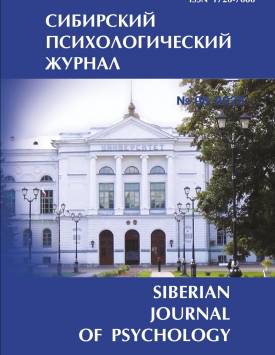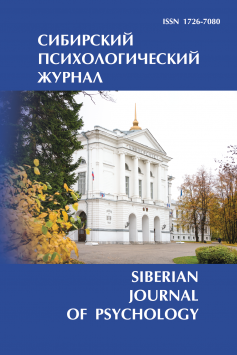What Teenagers and Young People are Afraid of: Fears of the Digital Generation in the Context of Global Crisis Situations
The work is devoted to studying the dynamics of fear patterns among adolescents and young people in Russia during 2021-2022. The purpose of the study is to examine the expression and dynamics of fears during the second wave of self-isolation amid the pandemic and the special military operation. It focuses on representatives of the digital generation with varying levels of user activity, sense of life in mixed reality, and digital competence. The study sample included 1,087 individuals aged 14-29 in 2021 and 1,548 individuals aged 14-30 in 2022. Methods. User activity and the sense of living in mixed reality were measured using closed-ended multiple-choice questions. Respondents selected fears from a provided list of 33 items. Additional methods included a life satisfaction scale and a screening version of the digital competence index. Results. In both years, the digital generation expressed the greatest concern about the potential illness and death of loved ones. By 2022, fears related to threats to physical well-being reached the same level of intensity as fears related to self-actualization. In 2021, adolescents and young adults with higher life satisfaction reported living in the real world (r = 0.32**) and were most concerned about threats to physical well-being (F = 14.71**) and global problems (F = 18.92**). During this period, respondents with higher user activity (X; = 16.44**, Cramer's V = 0.12**) and digital competence (F = 8.47**) were more likely to worry about a lack of self-actualization. Additionally, in 2021, respondents who reported living in the real world were more satisfied with their lives (r = 0.32**). By 2022, these differences had diminished. Conclusions. In situations of global crises, the digital generation's fears shift from self-actualization to survival-related concerns, such as fears for the life and health of loved ones, personal safety, and global events beyond their control but affecting them. However, based on global trends, if threats are removed, it is possible to quickly transition from survival-oriented values back to self-realization values. Global events reshape the landscape of young people's fears and present new challenges in coping with change and developing strategies for living in an anxious world. For the digital generation, the digitalization of all spheres of life and the emergence of mixed reality - where the physical is complemented by the digital - serve as significant resources for addressing "traditional" fears, which are further intensified by growing uncertainty and challenges of the real world.
Keywords
digital generation,
global crises,
fears,
digital socialization,
adolescents,
young people,
user activity,
life satisfactionAuthors
| Soldatova Galina U. | Moscow Institute of Psychoanalysis; Lomonosov Moscow State University; Russian Academy of National Economy and Public Administration | soldatova.galina@gmail.com |
| Ilyukhina Svetlana N. | Moscow Institute of Psychoanalysis; Lomonosov Moscow State University | svetla.iluhina@gmail.com |
| Klishevich Anastasia S. | Moscow Institute of Psychoanalysis; Lomonosov Moscow State University | anastasia.klishevich@yandex.ru |
Всего: 3
References
Абакумова, Т. В. (2002). Классификация основных видов страха современного общества. В кн.: Социальная психология: диалог Санкт-Петербург - Якутск: материалы науч. конф. 25-26 октября 2001 г. (с. 133-140). СПб.: СПбГУ.
Абрамова, С. Б., Антонова, Н. Л. (2021). Жизнь в режиме онлайн в условиях пандемии: страхи и тревоги молодого поколения. В сб.: Т. А. Сенюшкина (ред.). Политическое пространство и социальное время: глобальные вызовы и цивилизационные ответы: сб. науч. тр. УХХУПМеждунар. Харакского форума: в 2 т. (т. 1; с. 3-9). Симферополь: Тип. «Ариал».
Баринов, Д. Н. (2019). Страх как социальный феномен. Гуманитарный научный вестник, 2, 39-48. doi: 10.5281/zenodo.3236740.
Бердяев, Н. А. (2019). Экзистенциальная диалектика божественного и человеческого. М.: Директ-Медиа.
Бреслер, М. Г., Алексеева, Н. А. (2024) Живущие в цифровом мире. Надежда и страх будущего у поколения Z. Вестник Удмуртского университета. Социология. Политология. Международные отношения, 8(2), 165-173. doi: 10.35634/2587-9030-2024-8-2-165-173.
Витковская, М. И. (2003). Теоретико-методологические проблема: изучения «страха» в социологии. Вестник РУДН. Сер. Социология, 4-5, 86-91.
Гоббс, Т. (1989). Сочинения: в 2 т. М.: Мысль.
Даль, В. И. (1863). Толковый словарь живого великорусского языка. Ч. 4. М.: Изд. О-ва любителей российской словесности.
Декарт, Р. (1989). Сочинения: в 2 т. М.: Мысль.
Дерябин, В. С. (1944). Эмоции как источник силы. Наука и жизнь, 10, 21-25.
Дьяченко, О. Н. (2018) Конструирование человеческой личности в эпоху патристики. Гуманитарные исследования, 1(18), 33-36.
Захаров, А. И. (2000). Дневные и ночные страхи у детей. СПб.: Союз.
Камю, А. (2021) Бунтующий человек. Миф о Сизифе. М.: АСТ.
Карвасарский, Б. Д. (1990). Неврозы. М.: Медицина.
Кемпински А. (2000). Страх. В кн.: Л. В. Куликова (ред.). Психические состояния (с. 230-231). СПб.: Питер.
Кёлер, Х. (2003). Загадка страха. М.: Эвидентис.
Кьеркегор, С. (2014). Понятие страха. М. : Акад. проект.
Лайкам, К. Э., Бикбаева, А. Р., Павлова, Е. К. (2021). Влияние пандемии коронавируса на рынок труда. Федерализм, 26(4), 5-19. doi: 10.21686/2073-1051-2021-4-5-19.
Леонтьев А.Н. (1971) Потребности, мотивы, эмоции. М.: Изд-во Моск. ун-та.
Мамонтов, С. Ю. (2002). Страх. Практика преодоления. СПб.: Питер.
Матвеева, С. Я., Шляхентох, В. Э. (2000). Страхи в России: в прошлом и настоящем. Новосибирск: Сибирский хронограф.
Митина, О. В., Первичко, Е. И., Чижова, А. Р., Конюховская, Ю. Е. (2023). Структура ценностей во время пандемии COVID-19. Психология. Журнал Высшей ш.колы экономики, 20(4), 773-795. doi: 10.17323/1813-8918-2023-4-773-795.
Нарбут, Н. П., Троцук, И. В. (2014). Страхи и опасения российского студенчества: возможности эмпирической фиксации. Теория и практика общественного развития, 2, 69-74.
Нестик, Т. А. (2023) Психологическое состояние российского общества в условиях СВО. СоциоДиггер, 4(9(28)). URL: https://sociodigger.ru/artides/artides-page/psikholo gicheskoe-sostojanie-rossiiskogo-obshchestva-v-uslovijakh-svo#_ftn18.
Осин, Е. Н., Леонтьев, Д. А. (2008). Апробация русскоязычных версий двух шкал экспресс-оценки субъективного благополучия. В сб.: Материалы III Всероссийского социологического конгресса. М.: Ин-т социологии РАН; Рос. о-во социологов. URL: http://www.isras.ru/abstract_bank/1210190841.pdf.
Пищик, В. И., Лобачева, А. О. (2020). Объекта: веры и страхи студентов - представителей «информационного» и «нового» поколений. В сб.: Л. М. Митина (ред.). Межпоколенческие отношения: современный дискурс и стратегические выборы в психологопедагогической науке и практике: сб. тр. XVI междунар. науч.-практ. конф. (с. 251-254). М.: Психологический ин-т РАО.
Риман, Ф. (1999). Основные формы страха. М.: Алетейя.
Сартр, Ж.-П. (2015). Бытие и ничто: Опыт феноменологической онтологии. М.: АСТ. Семенихина, Д. А. (2022). Влияние пандемии COVID-19 на рынок труда в России. В сб.: Е. Г. Князева и др. (ред.). Весенние дни науки: сб. докладов Междунар. конф. студентов и молодых ученых, Екатеринбург, 21-23 апреля 2022 г. (с. 569-574). Екатеринбург: УрФУ.
Скосарь, В. С. (2024). Особенности проявления социальных страхов у молодежи. Актуальные исследования, 7(189), 74-77.
Солдатова, Г. У., Войскунский, А. Е. (2021). Социально-когнитивная концепция цифровой социализации: новая экосистема и социальная эволюция психики. Психология. Журнал Высшей Школы Экономики, 18(3), 431-450. doi: 10.17323/1813-8918-2021-3-431-450.
Солдатова, Г. У., Нестик, Т. А., Рассказова, Е. И., Зотова, Е. Ю. (2013). Цифровая компетентность российских подростков и родителей: результаты всероссийского исследования. М.: Фонд Развития Интернет.
Спиноза, Б. (2020). Этика. М.: Юрайт.
Тарабрина, Н. В., Харламенкова, Н. Е., Падун, М. А., Хажуев, И. С., Казымова, Н. Н., Быховец, Ю. В., Дан, М. В. (2017). Интенсивный стресс в контексте психологической безопасности. М.: Ин-т психологии РАН.
Фрейд, З. (1925). По ту сторону принципа удовольствия. М.: Современные проблемы. Н.А. Столляр.
Фрейд, З. (2018). Введение в психоанализ: лекции. М.: Эксмо-пресс.
Щербатых, Ю. В. (1999). Психология страха. М.: Эксмо-Пресс.
Bandura, A. (1977). Social-learning theory. New York: General Learning press.
Carpiniello, B. (2023). The Mental Health Costs of Armed Conflicts-A Review of Systematic Reviews Conducted on Refugees, Asylum-Seekers and People Living in War Zones. International Journal of Environmental Research and Public Health, 20(4), 2840. doi: 10.3390/ijerph20042840.
Diener, E. D., Emmons, R. A., Larsen, R. J., & Griffin, S. (1985) The Satisfaction with Life Scale. Journal of Personality Assessment, 49(1), 71-75. doi: 10.1207/s15327752jpa4901_13.
Duffy, M. E., Twenge, J. M., & Joiner, T. E. (2019). Trends in Mood and Anxiety Symptoms and Suicide-Related Outcomes Among U.S. Undergraduates, 2007-2018: Evidence From Two National Surveys. Journal of Adolescent Health, 65(5), 590-598. doi: 10.1016/j.jadohealth.2019.04.033.
Fontenelle, L. F., Albertella, L., Brierley, M. E., Thompson, E. M., Destr'ee, L., Chamberlain, S. R., & Yucel, M. (2021). Correlates of obsessive-compulsive and related disorders symptom severity during the COVID-19 pandemic. Journal of Psychiatric Research, 143, 471-480. doi: 10.1016/j. jpsychires.2021.03.046.
Hobbes, T. (1989). Sochineniya: v 2 t. [Works: in 2 vols]. Moscow: Mysl'.
Inglehart, R., & Weizel, C. (2005). Modernization, Cultural Change, and Democracy: The Human Development Sequence. Cambridge: Cambridge University Press.
Knowles, K. A., & Olatunji, B. O. (2021). Anxiety and safety behavior usage during the COVID-19 pandemic: The prospective role of contamination fear. Journal of Anxiety Disorders, 77, 102323. doi: 10.1016/j.janxdis.2020.102323 Kohler, H. (2003). Zagadka strakha [The Mystery of Fear]. Translated from German. Moscow: Evidentis.
Lawrence, K. C. (2020). Traumatising factors influencing interpersonal relationships of university students. Cogent Psychology, 7(1), 1835383. doi: 10.1080/23311908.2020.1835383.
Lestari, R., Yusuf, A., Hargono, R., Ahsan, A., Budi Setyawan, F. E., & Damayanti, N. A. (2020). The impact of social capital, demographic factors, and coping strategies on community adaptation in supporting people with severe mental illness. Journal of Public Health Research, 9(2), 1838. doi: 10.4081/jphr.2020.1838.
Mauer, V., Littleton, H., Lim, S., Sall, K., Siller, L. & Edwards, K. (2022). Fear of COVID-19, anxiety, and social support among college students. Journal of American College Health, 72, 1-8. doi: 10.1080/07448481.2022.2053689.
Morina, N., Stam, K., Pollet, T. V. & Priebe, S. (2018) Prevalence of Depression and Posttraumatic Stress Disorder in Adult Civilian Survivors of War Who Stay in War-Afflicted Regions. A Systematic Review and Meta-Analysis of Epidemiological Studies. Journal of Affective Disorders, 239, 328-338. doi: 10.1016/j.jad.2018.07.027.
Nikopoulou, V. A., Gliatas, I., Blekas, A., Parlapani, E., Holeva, V., Tsipropoulou, V., Kara-mouzi, P., Diakogiannis, I. (2022). Uncertainty, Stress, and Resilience During the COVID-19 Pandemic in Greece. The Journal of Nervous and Mental Disease, 210(4), 249-256. doi: 10.1097/NMD.0000000000001491.
Peiro, J. M., Luque-Garcia, A., Soriano, A., & Martinez-Tur, V. (2023). Fears during the Covid-19 pandemics and their influence on physical health: A cross-sectional study on the general population in Spain.International Journal of Clinical and Health Psychology, 23(2), 100361.
Rodriguez-Rey, R., Garrido-Hernansaiz, H., & Collado, S. (2020). Psychological impact of COVID-19 in Spain: Early data report. Psychological Trauma: Theory, Research, Practice, and Policy, 12(5), 550.
Schweda, A., Weismuller, B., Bauerle, A., Dorrie, N., Musche, V., Fink, M., Skoda, E. (2021). Phenotyping mental health: Age, community size, and depression differently modulate COVID-19-related fear and generalized anxiety.Comprehensive Psychiatry, 104, 152218. doi: 10.1016/j.comppsych.2020.152218.
Semenikhina, D. A. (2022). Vliyanie pandemii COVID-19 na rynok truda v Rossii [The Impact of the COVID-19 Pandemic on the Labor Market in Russia]. In E. G. Knyazeva et al. (Eds.), Vesennie dni nauki [Spring Days of Science] (pp. 569-574). Ekaterinburg: UrFU.
Smolnikova, L. V., Gorskikh, O. V., Raitina, M. Yu. & Suslova, T. I. (2020) Social Fears of Youth as an Actual Problem of a Modern University. Proceedings of the Conference "Integrating Engineering Education and Humanities for Global Intercultural Perspectives", 25-27March 2020, St. Petersburg, Russia, 685691. doi: 10.1007/978-3-030-47415-7_72.
Snel, E., Engbersen, G., De Boom, J., & Van Bochove, M. (2022). Social Capital as Protection Against the Mental Health Impact of the COVID-19 Pandemic. Frontiers in Sociology, 7. doi: 10.3389/fsoc.2022.728541.
Tomkins, S.S. (1970). Affect as the Primary Motivational System. In M. Arnold (Ed.), Feelins and Emotios (pp. 101 -110). New York: Academic Press.
Twenge, J. M. (2023). Generations. The Real Differences Between Gen Z, Millennials, Gen X, Boomers, and Silents - and America’s Future. New York: Atria books. Simon & Schuster.
Vitkovskaya, M. I. (2003). Teoretiko-metodologicheskie problemy izucheniya “stra-kha” v sotsiologii [Theoretical and methodological problems of studying “fear” in sociology]. Vestnik RUDN. Ser. Sotsiologiya, 4-5, 86-91.
Yang, Y., Huang, Y., Huang, J., & Nie, F. (2024). The role of social capital in the impact of multiple shocks on households’ coping strategies in underdeveloped rural areas. Science Report, 14, 14218. doi: 10.1038/s41598-024-65206-x Zakharov, A. I. (2000). Dnevnye i nochnye strakhi u detey [Daytime and Night Fears in Children]. St. Petersburg: Soyuz.

